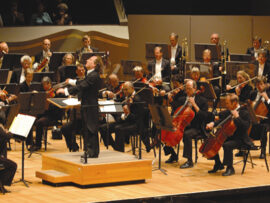A number of years ago I had the good fortune to attend a concert at Carnegie Hall. The experience was almost overwhelming. Having grown up in the Midwest, I had never been to a concert hall that even approached Carnegie Hall in sheer size and beauty. The concert showcased many Jewish music stars whose music I really enjoyed, but whom I had never seen in a live performance. But by far, the most memorable part of the evening was a performance by a Jewish 46-piece symphonic wind ensemblecomprised of students ofMoriah Collegein Sydney, Australia. These young Jewish artists performed with such professionalism and skill that for a moment I felt like I could have closed my eyes and imagined that I was listening to the New York Philharmonic Orchestra.
As my eyes wandered from the saxophones to the oboes, the French horns, and a slew of wind instruments, I realized that while each player was an individual talent, the musical beauty derived from the collective sound. The grandeur was in the symphony, and was a result of the synthesis of the various individual sounds into a harmonious whole.
In this week's Torah portion of Vayelech, the Almighty approaches Moshe at the end of his life and instructs him: "So now, write this song for yourselves and teach it to the children of Israel, place it in their mouths, so that this song shall be for me a witness for the children of Israel." This "song" actually refers to the next Torah portion of Haazinu, in which Moshe poetically calls heaven and earth to bear witness to the consequences of the Jewish people’s commitment to Torah and to God.
The commentaries all reflect on the song-like nature of this section. One explanation given is that the word “song” implies a certain sense of harmony. It challenges its readers to recognize the complete harmony in nature, and how all of reality fuses together to carry out the will of Hashem. Just as the sound of a 46-piece symphonic wind ensemble is the result of a harmonious cooperation of musicians to create a beautiful piece of music, the function of our universe is the harmonious cooperation of creation to carry out the Almighty's will.
A careful examination of this "song" reveals a disregard of basic grammar; the song often mixes the past, present and future as if they were one and the same. This idea surpasses even the brilliance of music, for a symphony is all in the present, each note played simultaneously. The "song" of Haazinu, however, encompasses a broader concept of reality in which existence is not just the sum total of each component of creation, but rather a timeless symphony in which past, present and future fuse together to fulfill the purpose of the Creator.
Our mystics teach us that in heaven the gate of Teshuvah, repentance and return, is adjacent to the gate of Neginah, music and song. Perhaps the reason for this juxtaposition is that just as the blended notes of symphonic sound can enhance our appreciation of music, similarly, one of the keys to return and repentance is to see ourselves in the context of a greater whole in which all of existence, in its entirety, works in unison to fulfill the will of the Almighty.
As we approach Rosh Hashanah, the time of year when the Supreme Conductor analyzes every component of His masterful symphony, let us ensure that his "instruments" are finely tuned, playing in rhythm, and actively contributing to the greatest of concertos: fulfilling the will of Hashem. s

